An Integrated Biorefinery Proof of Concept: The Synthesis of Fully Bio-Based, Functional Lignin Polyester Copolymers of Cyclic Anhydrides and Epoxides Towards Polyol Applications and Tunable Bio-Derived Materials
Abstract
1. Introduction
2. Results and Discussion
2.1. Development of a Catalytic ROCOP System for Lignin Model Epoxide Compounds and Phthalic Anhydride
2.2. Exploring Organo-Catalyzed PA/DCAGE ROCOP with Views to Further Material Applications
2.3. Blank Control ROCOP Reactions, Chain-Transfer Reactions, Self-Catalysis/Promoted ROCOP and [OH] Species
2.4. Mechanistic Considerations: Why the Increase in Rate with the Presence of [OH] Groups, the Role of the [OH] Groups, and an Alternative ROCOP Mechanism Proposed Inherent for Lignin
2.5. Organo-Catalyzed ROCOP with PA and LHOGE Sourced from the RCF of Pinus Radiata Biomass and Glycidylation
2.6. Organo-Catalyzed ROCOP of DCAGE and LHOGE with Succinic Anhydride
2.7. The Application of Lignin-Derived ROCOP Polyesters as Polyols for the Synthesis of Polyurethane Film Materials
3. Conclusions
Supplementary Materials
Author Contributions
Funding
Institutional Review Board Statement
Data Availability Statement
Acknowledgments
Conflicts of Interest
References
- O’Dea, R.M.; Willie, J.A.; Epps, T.H. 100th Anniversary of Macromolecular Science Viewpoint: Polymers from Lignocellulosic Biomass. Current Challenges and Future Opportunities. ACS Macro Lett. 2020, 9, 476–493. [Google Scholar] [CrossRef] [PubMed]
- Zhu, Y.; Romain, C.; Williams, C.K. Sustainable Polymers from Renewable Resources. Nature 2016, 540, 354–362. [Google Scholar] [CrossRef] [PubMed]
- Jones, M.D.; Payne, J. The Chemical Recycling of Polyesters for a Circular Plastics Economy: Challenges and Emerging Opportunities. ChemSusChem 2021, 14, 4041–4070. [Google Scholar] [CrossRef] [PubMed]
- Payne, J.; Mckeown, P.; Jones, M.D. A Circular Economy Approach to Plastic Waste. Polym. Degrad. Stab. 2019, 165, 170–181. [Google Scholar] [CrossRef]
- Ellen MacArthur Foundation. The New Plastics Economy: Rethinking the Future of Plastics; Routledge: London, UK, 2016. [Google Scholar] [CrossRef]
- Rabnawaz, M.; Wyman, I.; Auras, R.; Cheng, S. A Roadmap towards Green Packaging: The Current Status and Future Outlook for Polyesters in the Packaging Industry. Green. Chem. 2017, 19, 4737–4753. [Google Scholar] [CrossRef]
- Sanford, M.J.; Peña Carrodeguas, L.; van Zee, N.J.; Kleij, A.W. Alternating Copolymerization of Propylene Oxide and Cyclohexene Oxide with Tricyclic Anhydrides: Access to Partially Renewable Aliphatic Polyesters with High Glass Transition Temperatures. Macromolecules 2016, 49, 6394–6400. [Google Scholar] [CrossRef]
- Müller, R.J.; Kleeberg, I.; Deckwer, W.D. Biodegradation of Polyesters Containing Aromatic Constituents. J. Biotechnol. 2001, 86, 87–95. [Google Scholar] [CrossRef]
- Vert, M. Aliphatic Polyesters: Great Degradable Polymers That Cannot Do Everything. Biomacromolecules 2005, 6, 538–546. [Google Scholar]
- Brown, A.H.; Sheares, V.V. Amorphous Unsaturated Aliphatic Polyesters Derived from Dicarboxylic Monomers Synthesized by Diels-Alder Chemistry. Macromolecules 2007, 40, 4848–4853. [Google Scholar] [CrossRef]
- Olson, D.A.; Gratton, S.E.A.; DeSimone, J.M.; Sheares, V.V. Amorphous Linear Aliphatic Polyesters for the Facile Preparation of Tunable Rapidly Degrading Elastomeric Devices and Delivery Vectors. J. Am. Chem. Soc. 2006, 128, 13625–13633. [Google Scholar] [CrossRef]
- Ryzhakov, D.; Printz, G.; Jacques, B.; Messaoudi, S.; Dumas, F.; Dagorne, S.; Le Bideau, F. Organo-Catalyzed/Initiated Ring Opening Co-Polymerization of Cyclic Anhydrides and Epoxides: An Emerging Story. Polym. Chem. 2021, 12, 2932–2946. [Google Scholar] [CrossRef]
- Longo Julie, M.; Sanford, M.J.; Coates, G.W. Ring-Opening Copolymerization of Epoxides and Cyclic Anhydrides with Discrete Metal Complexes: Structure−Property Relationships. Chem. Rev. 2016, 116, 15167–15197. [Google Scholar] [CrossRef]
- Lidston, C.A.L.; Severson, S.M.; Abel, B.A.; Coates, G.W. Multifunctional Catalysts for Ring-Opening Copolymerizations. ACS Catal. 2022, 12, 11037–11070. [Google Scholar] [CrossRef]
- Thomas, C.M. Stereocontrolled Ring-Opening Polymerization of Cyclic Esters: Synthesis of New Polyester Microstructures. Chem. Soc. Rev. 2010, 39, 165–173. [Google Scholar] [CrossRef] [PubMed]
- Stanford, M.J.; Dove, A.P. Stereocontrolled Ring-Opening Polymerisation of Lactide. Chem. Soc. Rev. 2010, 39, 486–494. [Google Scholar] [CrossRef] [PubMed]
- Dechy-Cabaret, O.; Martin-Vaca, B.; Bourissou, D. Controlled Ring-Opening Polymerization of Lactide and Glycolide. Chem. Rev. 2004, 104, 6147–6176. [Google Scholar] [CrossRef]
- Paul, S.; Zhu, Y.; Romain, C.; Brooks, R.; Saini, P.K.; Williams, C.K. Ring-Opening Copolymerization (ROCOP): Synthesis and Properties of Polyesters and Polycarbonates. Chem. Commun. 2015, 51, 6459–6479. [Google Scholar] [CrossRef]
- Gregory, G.L.; Sulley, G.S.; Carrodeguas, L.P.; Chen, T.T.D.; Santmarti, A.; Terrill, N.J.; Lee, K.-Y.; Williams, C.K. Triblock Polyester Thermoplastic Elastomers with Semi-Aromatic Polymer End Blocks by Ring-Opening Copolymerization. Chem. Sci. 2020, 11, 6567–6581. [Google Scholar] [CrossRef]
- Kummari, A.; Pappuru, S.; Chakraborty, D. Fully Alternating and Regioselective Ring-Opening Copolymerization of Phthalic Anhydride with Epoxides Using Highly Active Metal-Free Lewis Pairs as a Catalyst. Polym. Chem. 2018, 9, 4052–4062. [Google Scholar] [CrossRef]
- Brochu, S.; Prud’homme, R.E.; Barakat, I.; Jérôme, R. Stereocomplexation and Morphology of Polylactides. Macromolecules 1995, 28, 5230–5239. [Google Scholar] [CrossRef]
- Tsuji, H. Poly(Lactide) Stereocomplexes: Formation, Structure, Properties, Degradation, and Applications. Macromol. Biosci. 2005, 5, 569–597. [Google Scholar] [CrossRef]
- Garlotta, D. Literature Review of Poly (Lactic Acid). J. Polym. Environ. 2001, 9, 63–84. [Google Scholar] [CrossRef]
- Nampoothiri, M.K.; Nair, N.R.; John, R.P. An Overview of the Recent Developments in Polylactide (PLA) Research. Bioresour. Technol. 2010, 101, 8493–8501. [Google Scholar] [CrossRef] [PubMed]
- Stolt, M.; Södergård, A. Properties of Lactic Acid Based Polymers and Their Correlation with Composition. Prog. Polym. Sci. 2002, 27, 1123–1163. [Google Scholar] [CrossRef]
- Rieger, J. The Glass Transition Temperature of Polystyrene. J. Thermal. Anal. 1996, 46, 965–972. [Google Scholar] [CrossRef]
- Hosseini Nejad, E.; Paoniasari, A.; Koning, C.E.; Duchateau, R. Semi-Aromatic Polyesters by Alternating Ring-Opening Copolymerisation of Styrene Oxide and Anhydrides. Polym. Chem. 2012, 3, 1308–1313. [Google Scholar] [CrossRef]
- Nejad Elham, H.; van Melis Carlo, G.W.; Vermeer, T.J.; Koning, C.E.; Duchateau, R. Alternating Ring-Opening Polymerization of Cyclohexene Oxide and Anhydrides: Effect of Catalyst, Cocatalyst, and Anhydride Structure. Macromolecules 2012, 45, 1770–1776. [Google Scholar] [CrossRef]
- Nejad, E.H.; Paoniasari, A.; Van Melis, C.G.W.; Koning, C.E.; Duchateau, R. Catalytic Ring-Opening Copolymerization of Limonene Oxide and Phthalic Anhydride: Toward Partially Renewable Polyesters. Macromolecules 2013, 46, 631–637. [Google Scholar] [CrossRef]
- Mundil, R.; Hošťálek, Z.; Šeděnková, I.; Merna, J. Alternating Ring-Opening Copolymerization of Cyclohexene Oxide with Phthalic Anhydride Catalyzed by Iron(III) Salen Complexes. Macromol. Res. 2015, 23, 161–166. [Google Scholar] [CrossRef]
- Stößer, T.; Williams, C.K. Selective Polymerization Catalysis from Monomer Mixtures: Using a Commercial Cr-Salen Catalyst To Access ABA Block Polyesters. Angew. Chem. Int. Ed. 2018, 57, 6337–6341. [Google Scholar] [CrossRef]
- Bester, K.; Bukowska, A.; Myśliwiec, B.; Hus, K.; Tomczyk, D.; Urbaniak, P.; Bukowski, W. Alternating Ring-Opening Copolymerization of Phthalic Anhydride with Epoxides Catalysed by Salophen Chromium(III) Complexes. Eff. Substituents Salophen Ligands. Polym. Chem. 2018, 9, 2147–2156. [Google Scholar]
- Winkler, M.; Romain, C.; Meier, M.A.R.; Williams, C.K. Renewable Polycarbonates and Polyesters from 1,4-Cyclohexadiene. Green. Chem. 2015, 17, 300–306. [Google Scholar] [CrossRef]
- Williams, C.K.; Hillmyer, M.A. Polymers from Renewable Resources: A Perspective for a Special Issue of Polymer Reviews. Polym. Rev. 2008, 48, 1–10. [Google Scholar] [CrossRef]
- Brandolese, A.; della Monica, F.; Pericàs, M.À.; Kleij, A.W. Catalytic Ring-Opening Copolymerization of Fatty Acid Epoxides: Access to Functional Biopolyesters. Macromolecules 2022, 55, 2566–2573. [Google Scholar] [CrossRef] [PubMed]
- Liu, B.; Chen, J.; Liu, N.; Ding, H.; Wu, X.; Dai, B.; Kim, I. Bio-Based Polyesters Synthesized by Ring-Opening Copolymerizations of Eugenyl Glycidyl Ether and Cyclic Anhydrides Using a Binuclear [OSSO] CrCl Complex. Green. Chem. 2020, 22, 5742–5750. [Google Scholar] [CrossRef]
- Peña Carrodeguas, L.; Martín, C.; Kleij, A.W. Semiaromatic Polyesters Derived from Renewable Terpene Oxides with High Glass Transitions. Macromolecules 2017, 50, 5337–5345. [Google Scholar] [CrossRef]
- Monica, F.D.; Kleij, A.W. Synthesis and Characterization of Biobased Polyesters with Tunable Tgby ROCOP of Beta-Elemene Oxides and Phthalic Anhydride. ACS Sustain. Chem. Eng. 2021, 9, 2619–2625. [Google Scholar] [CrossRef]
- Chen, T.T.D.; Carrodeguas, L.P.; Sulley, G.S.; Gregory, G.L.; Williams, C.K. Bio-based and Degradable Block Polyester Pressure-Sensitive Adhesives. Angew. Chem. Int. Ed. 2020, 59, 23450–23455. [Google Scholar] [CrossRef]
- Haslewood, M.N.D.; Farmer, T.J.; North, M. Synthesis and Chemoselective Crosslinking of Functionalized Polyesters from Bio-Based Epoxides and Cyclic Anhydrides. J. Polym. Sci. 2022, 61, 311–322. [Google Scholar] [CrossRef]
- Pagliaro, M.; Ciriminna, R.; Kimura, H.; Rossi, M.; Della Pina, C. From Glycerol to Value-Added Products. Angew. Chem. Int. Ed. 2007, 46, 4434–4440. [Google Scholar] [CrossRef]
- Solvay Epicerol® Earns Roundtable on Sustainable Biomaterials Certification. Available online: https://www.solvay.com/en/press-release/solvay-epicerol-earns-roundtable-sustainable-biomaterials-certification (accessed on 8 December 2022).
- INOVYN Launches World’s First Commercially Available Grade of Bio-Attributed Epichlorohydrin. Available online: https://www.ineos.com/businesses/inovyn/news/inovyn-launches-worlds-first-commercially-available-grade-of-bio-attributed-epichlorohydrin/ (accessed on 8 December 2022).
- Faye, I.; Decostanzi, M.; Ecochard, Y.; Caillol, S. Eugenol Bio-Based Epoxy Thermosets: From Cloves to Applied Materials. Green. Chem. 2017, 19, 5236–5242. [Google Scholar] [CrossRef]
- Morales-Cerrada, R.; Molina-Gutierrez, S.; Lacroix-Desmazes, P.; Caillol, S. Eugenol, a Promising Building Block for Biobased Polymers with Cutting-Edge Properties. Biomacromolecules 2021, 22, 3625–3648. [Google Scholar] [CrossRef]
- Nghiem, N.; Kleff, S.; Schwegmann, S. Succinic Acid: Technology Development and Commercialization. Fermentation 2017, 3, 26. [Google Scholar] [CrossRef]
- Putri, D.N.; Sahlan, M.; Montastruc, L.; Meyer, M.; Negny, S.; Hermansyah, H. Progress of Fermentation Methods for Bio-Succinic Acid Production Using Agro-Industrial Waste by Actinobacillus Succinogenes. Energy Rep. 2020, 6, 234–239. [Google Scholar] [CrossRef]
- Dickson, R.; Mancini, E.; Garg, N.; Woodley, J.M.; Gernaey, K.V.; Pinelo, M.; Liu, J.; Mansouri, S.S. Sustainable Bio-Succinic Acid Production: Superstructure Optimization, Techno-Economic, and Lifecycle Assessment. Energy Environ. Sci. 2021, 14, 3542–3558. [Google Scholar] [CrossRef]
- Pietraru, M.; Lentz, N.; Ponsard, L.; Nicolas, E.; Cantat, T. Catalytic Carbonylation of Acrylic Acid to Succinic Anhydride. ChemCatChem 2023, 15, e202300720. [Google Scholar] [CrossRef]
- Driscoll, O.J.; Stewart, J.A.; McKeown, P.; Jones, M.D. Ring-Opening Copolymerization Using Simple Fe(III) Complexes and Metal- and Halide-Free Organic Catalysts. Macromolecules 2021, 54, 8443–8452. [Google Scholar] [CrossRef]
- Hauenstein, O.; Reiter, M.; Agarwal, S.; Rieger, B.; Greiner, A. Bio-Based Polycarbonate from Limonene Oxide and CO2 with High Molecular Weight, Excellent Thermal Resistance, Hardness and Transparency. Green. Chem. 2016, 18, 760–770. [Google Scholar] [CrossRef]
- Hošťálek, Z.; Trhlíková, O.; Walterová, Z.; Martinez, T.; Peruch, F.; Cramail, H.; Merna, J. Alternating Copolymerization of Epoxides with Anhydrides Initiated by Organic Bases. Eur. Polym. J. 2017, 88, 433–447. [Google Scholar] [CrossRef]
- Robert, C.; Ohkawara, T.; Nozaki, K. Manganese-Corrole Complexes as Versatile Catalysts for the Ring-Opening Homo- and Co-Polymerization of Epoxide. Chem. Eur. J. 2014, 20, 4789–4795. [Google Scholar] [CrossRef]
- Nakano, K.; Kobayashi, K.; Ohkawara, T.; Imoto, H.; Nozaki, K. Copolymerization of Epoxides with Carbon Dioxide Catalyzed by Iron-Corrole Complexes: Synthesis of a Crystalline Copolymer. J. Am. Chem. Soc. 2013, 135, 8456–8459. [Google Scholar] [CrossRef]
- Saini, P.K.; Romain, C.; Zhu, Y.; Williams, C.K. Di-Magnesium and Zinc Catalysts for the Copolymerization of Phthalic Anhydride and Cyclohexene Oxide. Polym. Chem. 2014, 5, 6068–6075. [Google Scholar] [CrossRef]
- Diciccio, A.M.; Coates, G.W. Ring-Opening Copolymerization of Maleic Anhydride with Epoxides: A Chain-Growth Approach to Unsaturated Polyesters. J. Am. Chem. Soc. 2011, 133, 10724–10727. [Google Scholar] [CrossRef] [PubMed]
- Hu, L.; Zhang, C.; Wu, H.; Yang, J.; Liu, B.; Duan, H.; Zhang, X. Highly Active Organic Lewis Pairs for the Copolymerization of Epoxides with Cyclic Anhydrides: Metal-Free Access to Well-Defined Aliphatic Polyesters. Macromolecules 2018, 51, 3126–3134. [Google Scholar]
- Darensbourg, D.J.; Poland, R.R.; Escobedo, C. Kinetic Studies of the Alternating Copolymerization of Cyclic Acid Anhydrides and Epoxides, and the Terpolymerization of Cyclic Acid Anhydrides, Epoxides, and CO2 Catalyzed by (Salen)CrIIICl. Macromolecules 2012, 45, 2242–2248. [Google Scholar] [CrossRef]
- Shi, Z.; Jiang, Q.; Song, Z.; Wang, Z.; Gao, C. Dinuclear Iron(III) Complexes Bearing Phenylene—Bridged Bis(Amino Triphenolate) Ligands as Catalysts for the Copolymerization of Cyclohexene Oxide with Carbon Dioxide or Phthalic Anhydride. Polym. Chem. 2018, 9, 4733–4743. [Google Scholar] [CrossRef]
- Bio-Based, Commercial Itaconic Anhydride (Merck Ltd., Product Number: 259926). Available online: https://www.sigmaaldrich.com/GB/en/product/aldrich/259926 (accessed on 9 December 2022).
- Zhao, M.; Lu, X.; Zong, H.; Li, J.; Zhuge, B. Itaconic Acid Production in Microorganisms. Biotechnol. Lett. 2018, 40, 455–464. [Google Scholar] [CrossRef]
- Kolankowski, K.; Miętus, M.; Ruśkowski, P.; Gadomska-Gajadhur, A. Optimisation of Glycerol and Itaconic Anhydride Polycondensation. Molecules 2022, 27, 4627. [Google Scholar] [CrossRef]
- Shang, S.; Huang, S.J.; Weiss, R.A. Synthesis and Characterization of Itaconic Anhydride and Stearyl Methacrylate Copolymers. Polymer 2009, 50, 3119–3127. [Google Scholar] [CrossRef]
- Okuda, T.; Ishimoto, K.; Ohara, H.; Kobayashi, S. Renewable Biobased Polymeric Materials: Facile Synthesis of Itaconic Anhydride-Based Copolymers with Poly(L-Lactic Acid) Grafts. Macromolecules 2012, 45, 4166–4174. [Google Scholar] [CrossRef]
- Schutyser, W.; Renders, T.; Van Den Bosch, S.; Koelewijn, S.F.; Beckham, G.T.; Sels, B.F. Chemicals from Lignin: An Interplay of Lignocellulose Fractionation, Depolymerisation, and Upgrading. Chem. Soc. Rev. 2018, 47, 852–908. [Google Scholar] [CrossRef]
- Liu, X.; Bouxin, F.P.; Fan, J.; Budarin, V.L.; Hu, C.; Clark, J.H. Recent Advances in the Catalytic Depolymerization of Lignin towards Phenolic Chemicals: A Review. ChemSusChem 2020, 13, 4296–4317. [Google Scholar] [CrossRef] [PubMed]
- Torr, K.M.; Driscoll, O.J.; van de Pas, D.J.; Feghali, E. Recent Advances in Thermoset and Thermoplastic Polymeric Materials Produced Using Technical and Depolymerized Native Lignins. In Lignin Chemistry; Wiley-VCH: Weinham, Germany, 2024. [Google Scholar] [CrossRef]
- Sun, Z.; Fridrich, B.; de Santi, A.; Elangovan, S.; Barta, K. Bright Side of Lignin Depolymerization: Toward New Platform Chemicals. Chem. Rev. 2018, 118, 614–678. [Google Scholar] [CrossRef] [PubMed]
- Wang, Y.-Y.; Meng, X.; Pu, Y.; J Ragauskas, A. Recent Advances in the Application of Functionalized Lignin in Value-Added Polymeric Materials. Polymers 2020, 12, 2277. [Google Scholar] [CrossRef] [PubMed]
- Yu, O.; Kim, K.H. Lignin to Materials: A Focused Review on Recent Novel Lignin Applications. Appl. Sci. 2020, 10, 4626. [Google Scholar] [CrossRef]
- Feghali, E.; van de Pas, D.J.; Torr, K.M. Toward Bio-Based Epoxy Thermoset Polymers from Depolymerized Native Lignins Produced at the Pilot Scale. Biomacromolecules 2020, 21, 1548–1559. [Google Scholar] [CrossRef]
- Quinsaat, J.E.Q.; Feghali, E.; van de Pas, D.J.; Vendamme, R.; Torr, K.M. Preparation of Mechanically Robust Bio-Based Polyurethane Foams Using Depolymerized Native Lignin. ACS Appl. Polym. Mater. 2021, 3, 5845–5856. [Google Scholar] [CrossRef]
- Chio, C.; Sain, M.; Qin, W. Lignin Utilization: A Review of Lignin Depolymerization from Various Aspects. Renew. Sustain. Energy Rev. 2019, 107, 232–249. [Google Scholar] [CrossRef]
- Korányi, T.I.; Fridrich, B.; Pineda, A.; Barta, K. Development of ‘Lignin-First’ Approaches for the Valorization of Lignocellulosic Biomass. Molecules 2020, 25, 2815. [Google Scholar] [CrossRef]
- Rao, N.; Guo, Y.; Li, H.; Chen, Q.; Li, Y.; Huang, Q.; Zhao, Z.K.; Xie, H. Synthesis of Multifunctional Lignin Graft Alternating Copolymers of Cyclic Anhydrides and Epoxides Catalyzed by Metal-Free Lewis Pairs. Ind. Crops Prod. 2024, 219, 119125. [Google Scholar] [CrossRef]
- Shao, X.; Su, L.; Zhang, J.; Tian, Z.; Zhang, N.; Wang, Y.; Wang, H.; Cui, X.; Hou, X.; Deng, T. Green Production of Phthalic Anhydride from Biobased Furan and Maleic Anhydride by an Acid Resin Catalyst. ACS Sustain. Chem. Eng. 2021, 9, 14385–14394. [Google Scholar] [CrossRef]
- Mahmoud, E.; Watson, D.A.; Lobo, R.F. Renewable Production of Phthalic Anhydride from Biomass-Derived Furan and Maleic Anhydride. Green. Chem. 2014, 16, 167–175. [Google Scholar] [CrossRef]
- Lin, Z.; Ierapetritou, M.; Nikolakis, V. Phthalic Anhydride Production from Hemicellulose Solutions: Technoeconomic Analysis and Life Cycle Assessment. AIChE J. 2015, 61, 3708–3718. [Google Scholar] [CrossRef]
- Settle, A.E.; Berstis, L.; Rorrer, N.A.; Roman-Leshkóv, Y.; Beckham, G.T.; Richards, R.M.; Vardon, D.R. Heterogeneous Diels–Alder Catalysis for Biomass-Derived Aromatic Compounds. Green. Chem. 2017, 19, 3468–3492. [Google Scholar] [CrossRef]
- (R,R)-N,N′-Bis(3,5-di-tert-butylsalicylidene)-1,2-cyclohexanediaminochromium(III) chloride (Merck Ldt., Product Number: 531944). Available online: https://www.sigmaaldrich.com/GB/en/product/aldrich/531944 (accessed on 9 December 2022).
- Denny, J. Biobased Phthalic Anhydride: Can This Key Feedstock Be Green? Available online: https://www.orbichem.com/blog/a-green-future-for-phthalic-anhydride-biomass-boost (accessed on 9 December 2022).
- Thiyagarajan, S.; Genuino, H.C.; Śliwa, M.; van der Waal, J.C.; de Jong, E.; van Haveren, J.; Weckhuysen, B.M.; Bruijnincx, P.C.A.; van Es, D.S. Substituted Phthalic Anhydrides from Biobased Furanics: A New Approach to Renewable Aromatics. ChemSusChem 2015, 8, 3052–3056. [Google Scholar] [CrossRef]
- Yu, X.; Jia, J.; Xu, S.; Lao, K.U.; Sanford, M.J.; Ramakrishnan, R.K.; Nazarenko, S.I.; Hoye, T.R.; Coates, G.W.; DiStasio, R.A. Unraveling Substituent Effects on the Glass Transition Temperatures of Biorenewable Polyesters. Nat. Commun. 2018, 9, 2880. [Google Scholar] [CrossRef]
- Van den Bosch, S.; Schutyser, W.; Koelewijn, S.-F.; Renders, T.; Courtin, C.M.; Sels, B.F. Tuning the Lignin Oil OH-Content with Ru and Pd Catalysts during Lignin Hydrogenolysis on Birch Wood. Chem. Commun. 2015, 51, 13158–13161. [Google Scholar] [CrossRef]
- Parsell, T.; Yohe, S.; Degenstein, J.; Jarrell, T.; Klein, I.; Gencer, E.; Hewetson, B.; Hurt, M.; Kim, J.I.; Choudhari, H.; et al. A Synergistic Biorefinery Based on Catalytic Conversion of Lignin Prior to Cellulose Starting from Lignocellulosic Biomass. Green. Chem. 2015, 17, 1492–1499. [Google Scholar] [CrossRef]
- Zhang, J.; Wang, L.; Liu, S.; Li, Z. Phosphazene/Lewis Acids as Highly Efficient Cooperative Catalyst for Synthesis of High-Molecular-Weight Polyesters by Ring-Opening Alternating Copolymerization of Epoxide and Anhydride. J. Polym. Sci. 2020, 58, 803–810. [Google Scholar] [CrossRef]
- Han, B.; Zhang, L.; Liu, B.; Dong, X.; Kim, I.; Duan, Z.; Theato, P. Controllable Synthesis of Stereoregular Polyesters by Organocatalytic Alternating Copolymerizations of Cyclohexene Oxide and Norbornene Anhydrides. Macromolecules 2015, 48, 3431–3437. [Google Scholar] [CrossRef]
- Ji, H.-Y.; Chen, X.-L.; Wang, B.; Pan, L.; Li, Y.-S. Metal-Free, Regioselective and Stereoregular Alternating Copolymerization of Monosubstituted Epoxides and Tricyclic Anhydrides. Green. Chem. 2018, 20, 3963–3973. [Google Scholar] [CrossRef]
- Pappuru, S.; Chakraborty, D. Progress in Metal-Free Cooperative Catalysis for the Ring-Opening Copolymerization of Cyclic Anhydrides and Epoxides. Eur. Polym. J. 2019, 121, 109276. [Google Scholar] [CrossRef]
- Torr, K.M.; van de Pas, D.J.; Cazeils, E.; Suckling, I.D. Mild Hydrogenolysis of In-Situ and Isolated Pinus Radiata Lignins. Bioresour. Technol. 2011, 102, 7608–7611. [Google Scholar] [CrossRef] [PubMed]
- Van den Bosch, S.; Schutyser, W.; Vanholme, R.; Driessen, T.; Koelewijn, S.-F.; Renders, T.; De Meester, B.; Huijgen, W.J.J.; Dehaen, W.; Courtin, C.M.; et al. Reductive Lignocellulose Fractionation into Soluble Lignin-Derived Phenolic Monomers and Dimers and Processable Carbohydrate Pulps. Energy Environ. Sci. 2015, 8, 1748–1763. [Google Scholar] [CrossRef]
- Driscoll, O.J.; Van Hecke, K.; Vande Velde, C.M.L.; Blockhuys, F.; Rubens, M.; Kuwaba, T.; van de Pas, D.J.; Eevers, W.; Vendamme, R.; Feghali, E. Solid-State Structures and Properties of Lignin Hydrogenolysis Oil Compounds: Shedding a Unique Light on Lignin Valorization. Int. J. Mol. Sci. 2024, 25, 10810. [Google Scholar] [CrossRef] [PubMed]
- Quinsaat, J.E.Q.; Falireas, P.G.; Feghali, E.; Torr, K.M.; Vanbroekhoven, K.; Eevers, W.; Vendamme, R. Depolymerised Lignin Oil: A Promising Building Block towards Thermoplasticity in Polyurethanes. Ind. Crops Prod. 2023, 194, 116305. [Google Scholar] [CrossRef]
- Wu, X.; Chen, C.; Guo, Z.; North, M.; Whitwood, A.C. Metal- and Halide-Free Catalyst for the Synthesis of Cyclic Carbonates from Epoxides and Carbon Dioxide. ACS Catal. 2019, 9, 1895–1906. [Google Scholar] [CrossRef]
- Inoue, S. Immortal Polymerization: The Outset, Development, and Application. J. Polym. Sci. A Polym. Chem. 2000, 38, 2861–2871. [Google Scholar] [CrossRef]
- Byers, J.A.; Biernesser, A.B.; Delle Chiaie, K.R.; Kaur, A.; Kehl, J.A. Catalytic Systems for the Production of Poly (Lactic Acid). In Advances in Polymer Science 279: Synthesis, Structure and Properties of Poly(lactic acid); Di Lorenzo, M.L., Androsch, R., Eds.; Springer International Publishing: Cham, Germany, 2018. [Google Scholar] [CrossRef]
- Shellard, E.J.K.; Diment, W.T.; Resendiz-Lara, D.A.; Fiorentini, F.; Gregory, G.L.; Williams, C.K. Al(III)/K(I) Heterodinuclear Polymerization Catalysts Showing Fast Rates and High Selectivity for Polyester Polyols. ACS Catal. 2024, 14, 1363–1374. [Google Scholar] [CrossRef]
- Lidston, C.A.L.; Abel, B.A.; Coates, G.W. Bifunctional Catalysis Prevents Inhibition in Reversible-Deactivation Ring-Opening Copolymerizations of Epoxides and Cyclic Anhydrides. J. Am. Chem. Soc. 2020, 142, 20161–20169. [Google Scholar] [CrossRef]
- Hu, C.; Chen, X.; Niu, M.; Zhang, Q.; Duan, R.; Pang, X. Immortal Ring-Opening Copolymerization of Epoxide and Isocyanate Using a Commercial Manganese Catalyst. Macromolecules 2022, 55, 652–657. [Google Scholar] [CrossRef]
- Sanford, M.J.; Van Zee, N.J.; Coates, G.W. Reversible-Deactivation Anionic Alternating Ring-Opening Copolymerization of Epoxides and Cyclic Anhydrides: Access to Orthogonally Functionalizable Multiblock Aliphatic Polyesters. Chem. Sci. 2018, 9, 134–142. [Google Scholar] [CrossRef]
- Vendamme, R.; Olaerts, K.; Gomes, M.; Degens, M.; Shigematsu, T.; Eevers, W. Interplay Between Viscoelastic and Chemical Tunings in Fatty-Acid-Based Polyester Adhesives: Engineering Biomass toward Functionalized Step-Growth Polymers and Soft Networks. Biomacromolecules 2012, 13, 1933–1944. [Google Scholar] [CrossRef]
- Scarica, C.; Suriano, R.; Levi, M.; Turri, S.; Griffini, G. Lignin Functionalized with Succinic Anhydride as Building Block for Biobased Thermosetting Polyester Coatings. ACS Sustain. Chem. Eng. 2018, 6, 3392–3401. [Google Scholar] [CrossRef]
- Vendamme, R.; Eevers, W. Sweet Solution for Sticky Problems: Chemoreological Design of Self-Adhesive Gel Materials Derived from Lipid Biofeedstocks and Adhesion Tailoring via Incorporation of Isosorbide. Macromolecules 2013, 46, 3395–3405. [Google Scholar] [CrossRef]
- Quinsaat, J.E.Q.; Feghali, E.; van de Pas, D.J.; Vendamme, R.; Torr, K.M. Preparation of Biobased Nonisocyanate Polyurethane/Epoxy Thermoset Materials Using Depolymerized Native Lignin. Biomacromolecules 2022, 23, 4562–4573. [Google Scholar] [CrossRef] [PubMed]
- van de Pas, D.J.; Nanayakkara, B.; Suckling, I.D.; Torr, K.M. Comparison of Hydrogenolysis with Thioacidolysis for Lignin Structural Analysis. Holzforschung 2014, 68, 151–155. [Google Scholar] [CrossRef]
- Gracia-Vitoria, J.; Rubens, M.; Feghali, E.; Adriaensens, P.; Vanbroekhoven, K.; Vendamme, R. Low-Field Benchtop versus High-Field NMR for Routine 31P Analysis of Lignin, a Comparative Study. Ind. Crops Prod. 2022, 176, 114405. [Google Scholar] [CrossRef]
- Granata, A.; Argyropoulos, D.S. 2-Chloro-4,4,5,5-Tetramethyl-1,3,2-Dioxaphospholane, a Reagent for the Accurate Determination of the Uncondensed and Condensed Phenolic Moieties in Lignins. J. Agric. Food Chem. 1995, 43, 1538–1544. [Google Scholar] [CrossRef]
- Meng, X.; Crestini, C.; Ben, H.; Hao, N.; Pu, Y.; Ragauskas, A.J.; Argyropoulos, D.S. Determination of Hydroxyl Groups in Biorefinery Resources via Quantitative 31P NMR Spectroscopy. Nat. Protoc. 2019, 14, 2627–2647. [Google Scholar] [CrossRef]
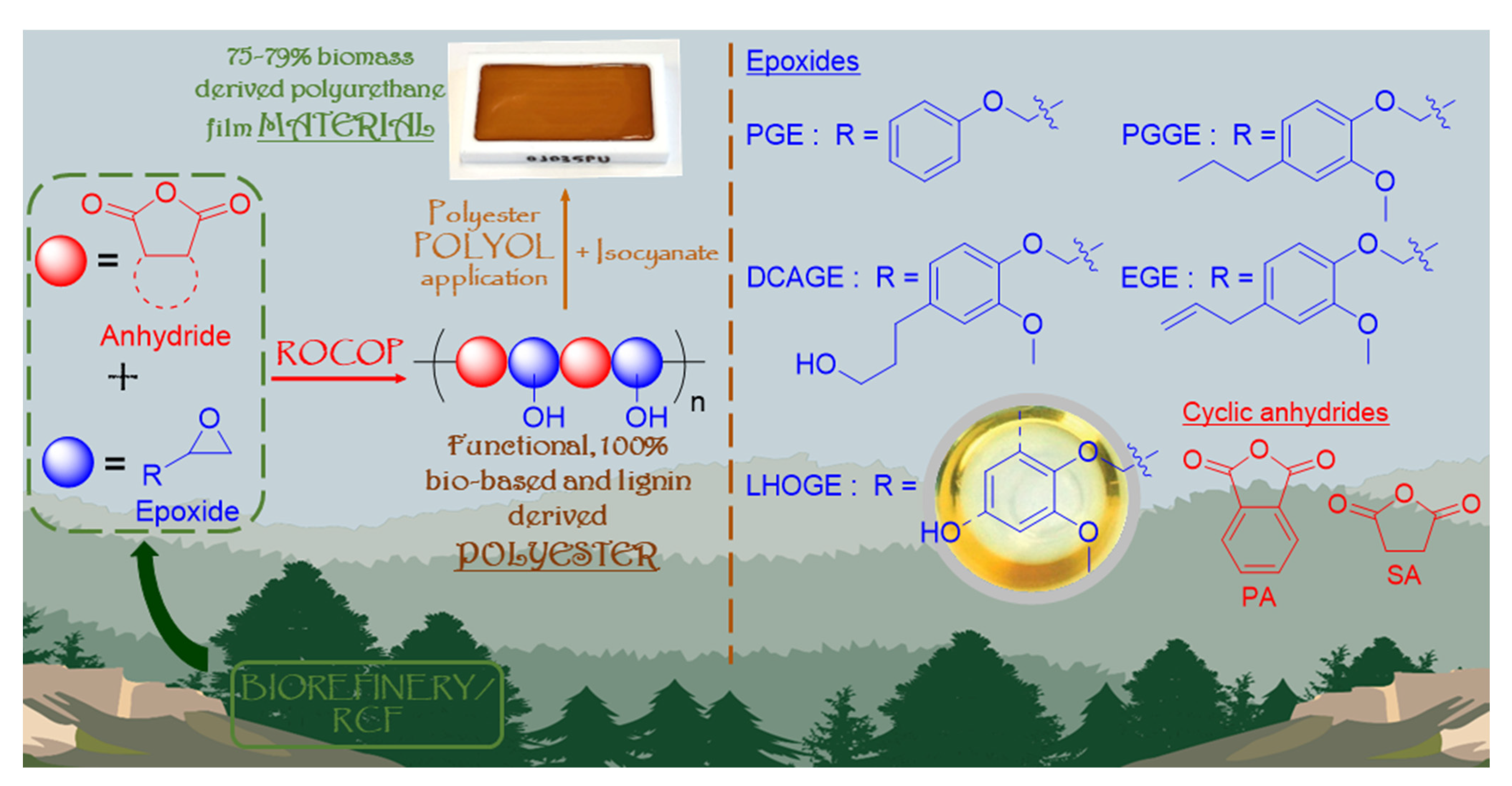
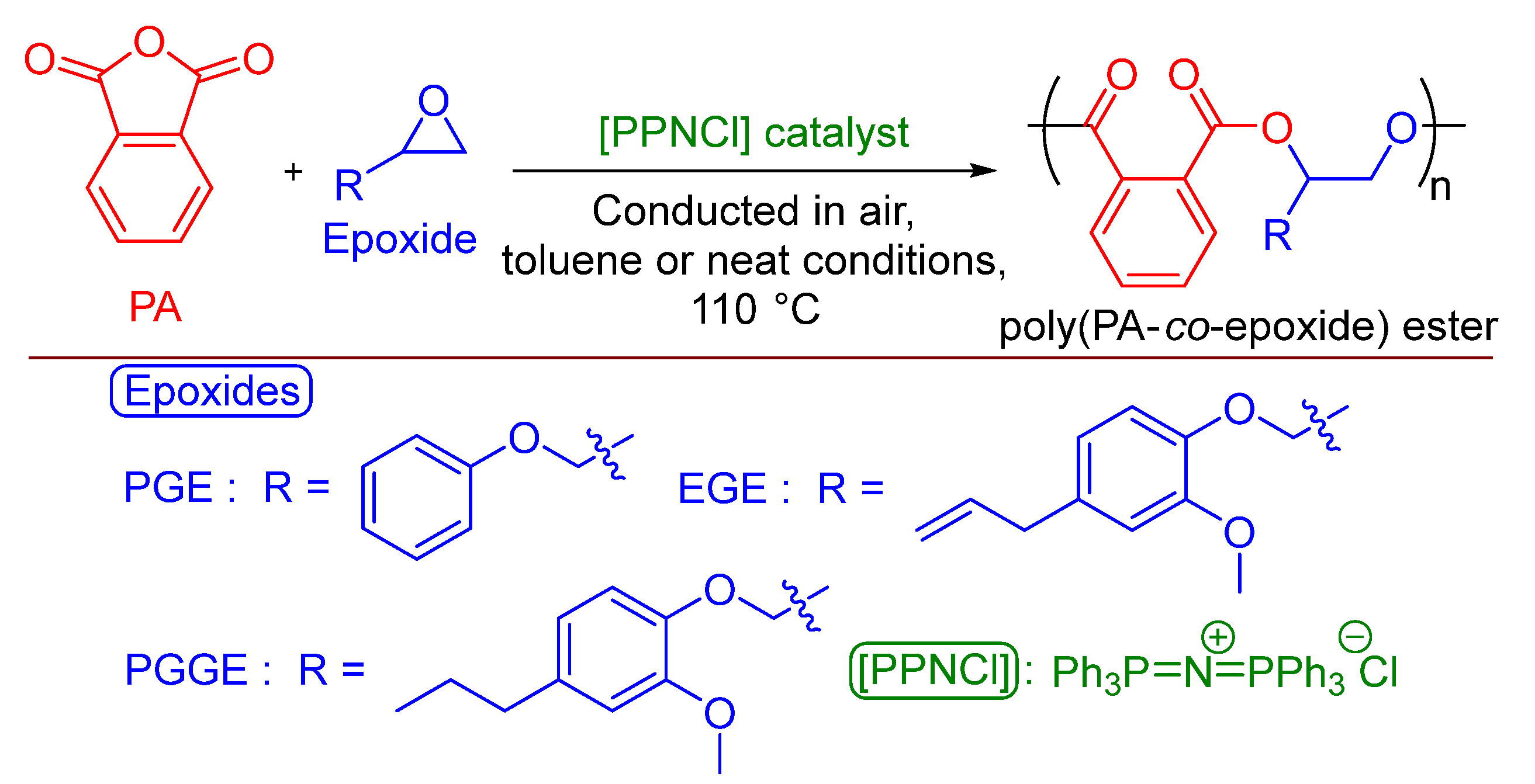
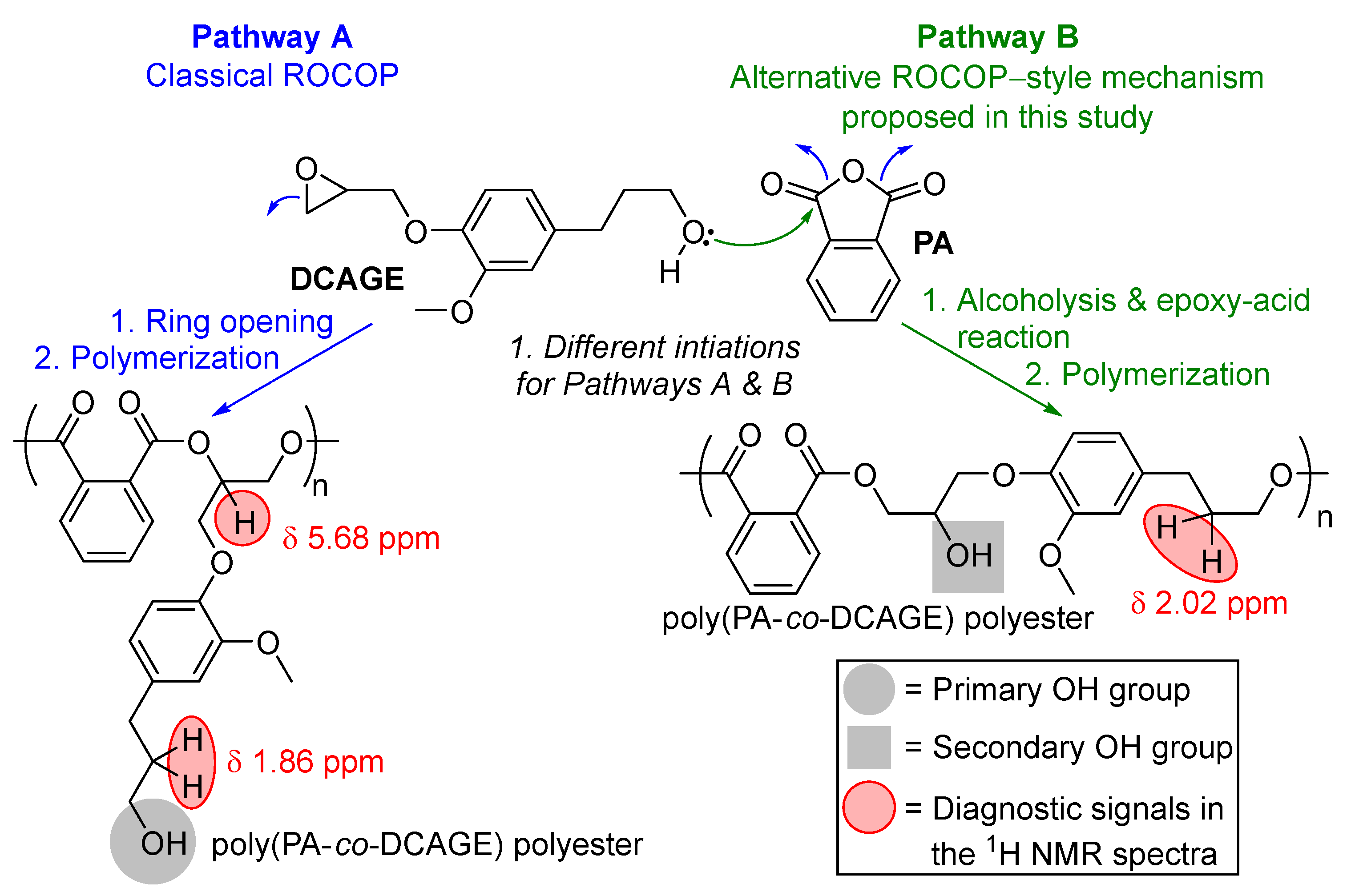
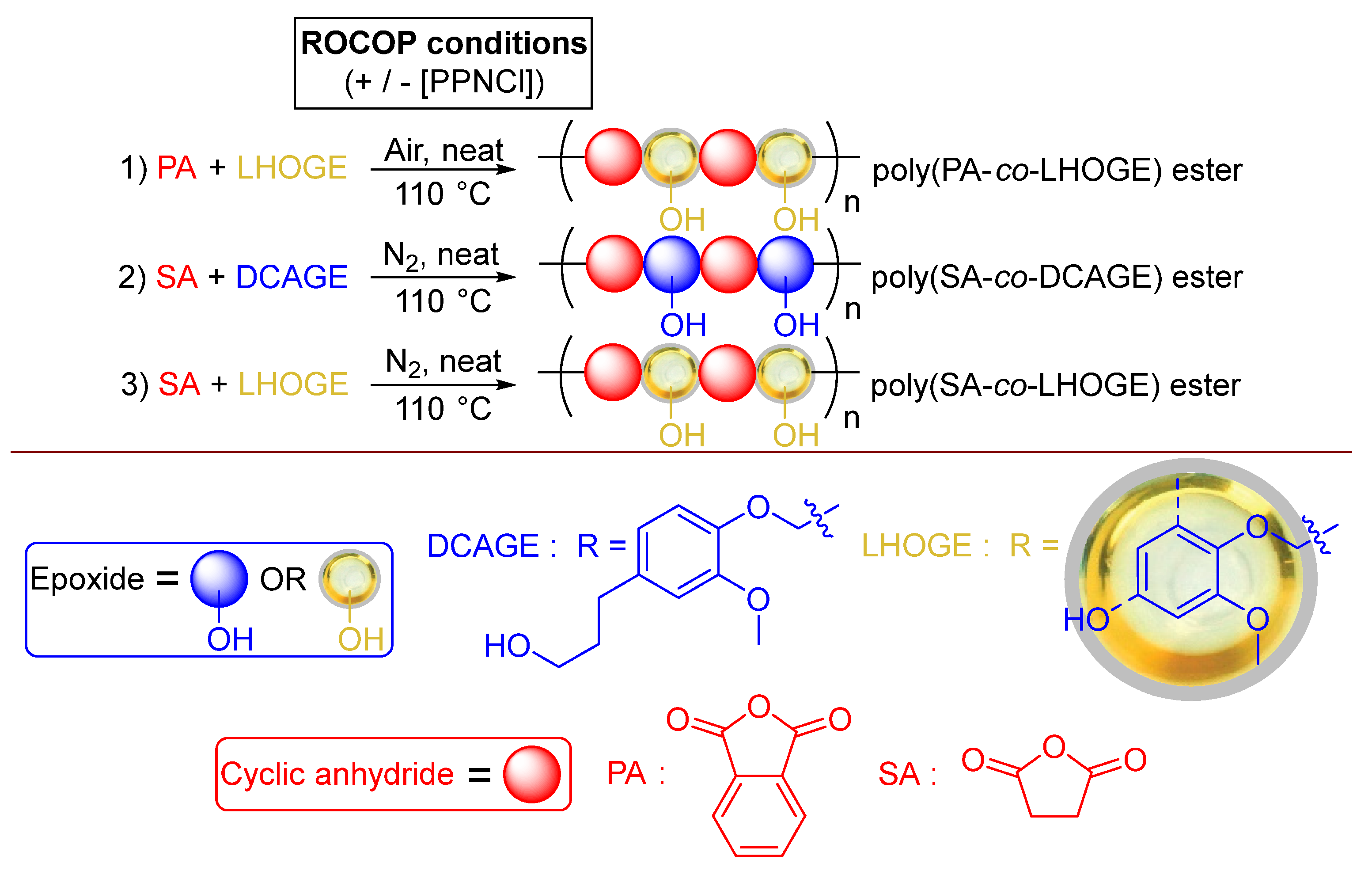
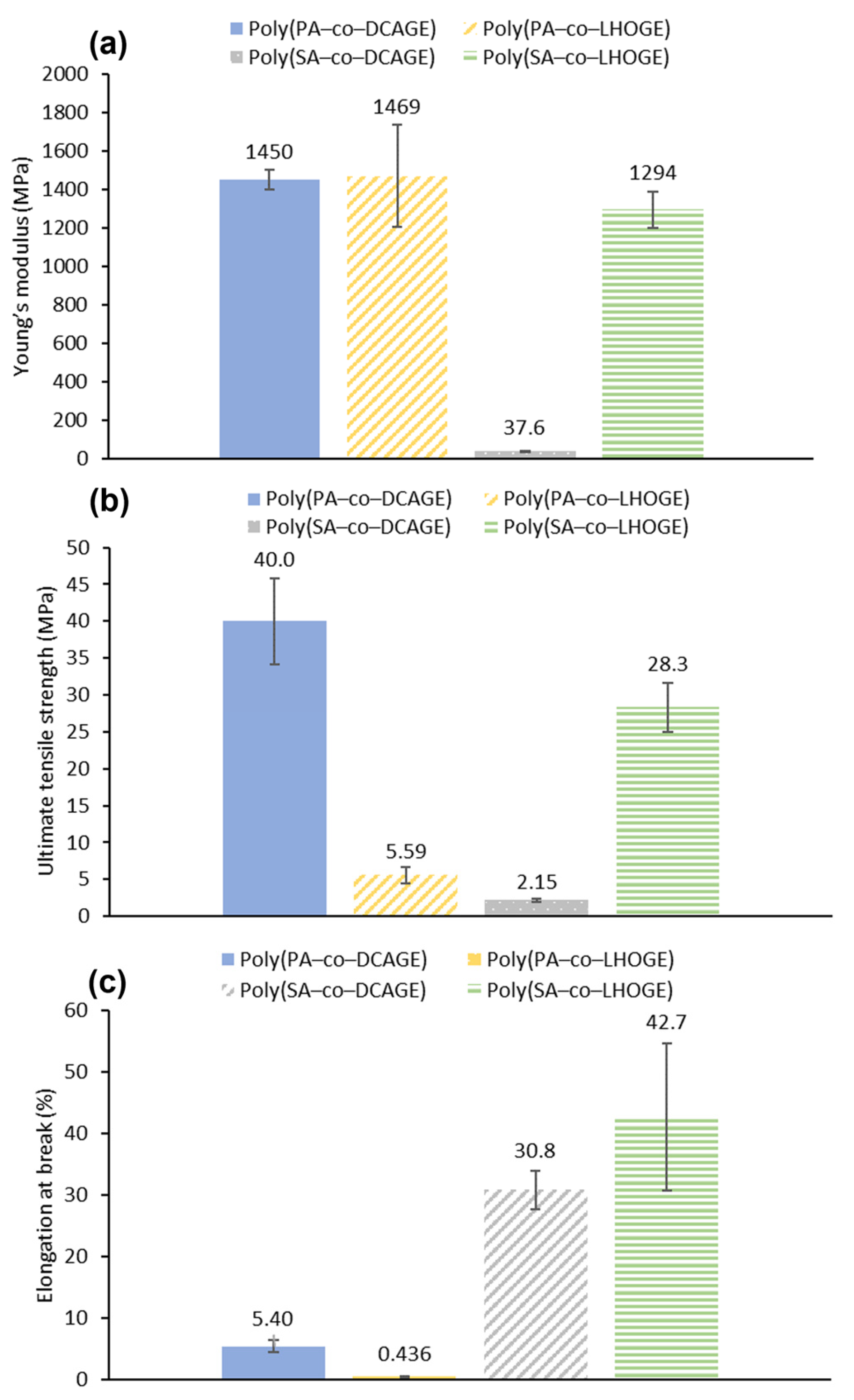
| Entry | Epoxide | Time (h) | Conv. a (%) | Mnb (Da) | Ð b | Tgc (°C) |
|---|---|---|---|---|---|---|
| 1 | PGE | 24 | 87 | 6850 | 1.12 | 43.8 |
| 2 | PGGE | 24 | 95 | 3400 | 1.31 | 30.2 |
| 3 | EGE | 24 | 95 | 3600 | 1.36 | 34.2 |
| 4 | DCAGE | 8 | 96 | 2700 | 1.96 | 33.8 |
| Entry | [PA]:[DCAGE]:[PPNCl] | Time (min) | PA Conv f (%) | Mng (Da) | Ð g | Total OH Value h (mmol/g) | ƒ i | Tgj (°C) |
|---|---|---|---|---|---|---|---|---|
| 1 a | [500]:[500]:[1] | 6 | 88 | 2650 | 1.78 | 3.11 | 8.2 | 37.9 |
| 2 a | [500]:[500]:[1] | 10 | >99 | 2800 | 1.78 | 3.13 | 8.8 | 37.0 |
| 3 b | [250]:[250]:[1] | 5 | 92 | 2650 | 1.79 | 3.07 | 8.1 | 33.0 |
| 4 c | [100]:[100]:[1] | 5 | 87 | 2800 | 1.51 | 3.22 | 9.0 | 31.2 |
| 5 d | [100]:[100]:[1] | 5 | 95 | 2050 | 1.52 | 3.46 | 7.1 | 30.5 |
| 6 e | [100]:[100]:[1] | 11 | 96 | 1950 | 1.58 | 2.33 | 4.5 | 29.5 |
| Polyester Polyol | Poly(PA–co–DCAGE) | Poly(PA-co-LHOGE) | Poly(SA–co–DCAGE) | Poly(SA–co–LHOGE) |
|---|---|---|---|---|
| Polyester sample source | Table 2, entry 4 | Table S8, entry 6 | Table S9, entry 3 | Table S9, entry 7 |
| Mn (Da) | 2800 | 2450 | 1100 | 2750 |
| [DCAGE/LHOGE content] (wt%) | 46 | 57 | 55 | 63 |
| [Biomass-derived content] (wt%) | 75 | 77 | 78 | 79 |
| Tg,tanδ (°C) | 73.8 ± 0.61 | 66.9 ± 1.4 | 10.1 ± 0.80 | 62.5 ± 1.6 |
Disclaimer/Publisher’s Note: The statements, opinions and data contained in all publications are solely those of the individual author(s) and contributor(s) and not of MDPI and/or the editor(s). MDPI and/or the editor(s) disclaim responsibility for any injury to people or property resulting from any ideas, methods, instructions or products referred to in the content. |
© 2025 by the authors. Licensee MDPI, Basel, Switzerland. This article is an open access article distributed under the terms and conditions of the Creative Commons Attribution (CC BY) license (https://creativecommons.org/licenses/by/4.0/).
Share and Cite
Driscoll, O.J.; van de Pas, D.J.; Torr, K.M.; Thomas, H.P.; Vendamme, R.; Feghali, E. An Integrated Biorefinery Proof of Concept: The Synthesis of Fully Bio-Based, Functional Lignin Polyester Copolymers of Cyclic Anhydrides and Epoxides Towards Polyol Applications and Tunable Bio-Derived Materials. Polymers 2025, 17, 2806. https://doi.org/10.3390/polym17202806
Driscoll OJ, van de Pas DJ, Torr KM, Thomas HP, Vendamme R, Feghali E. An Integrated Biorefinery Proof of Concept: The Synthesis of Fully Bio-Based, Functional Lignin Polyester Copolymers of Cyclic Anhydrides and Epoxides Towards Polyol Applications and Tunable Bio-Derived Materials. Polymers. 2025; 17(20):2806. https://doi.org/10.3390/polym17202806
Chicago/Turabian StyleDriscoll, Oliver J., Daniel J. van de Pas, Kirk M. Torr, Hayden P. Thomas, Richard Vendamme, and Elias Feghali. 2025. "An Integrated Biorefinery Proof of Concept: The Synthesis of Fully Bio-Based, Functional Lignin Polyester Copolymers of Cyclic Anhydrides and Epoxides Towards Polyol Applications and Tunable Bio-Derived Materials" Polymers 17, no. 20: 2806. https://doi.org/10.3390/polym17202806
APA StyleDriscoll, O. J., van de Pas, D. J., Torr, K. M., Thomas, H. P., Vendamme, R., & Feghali, E. (2025). An Integrated Biorefinery Proof of Concept: The Synthesis of Fully Bio-Based, Functional Lignin Polyester Copolymers of Cyclic Anhydrides and Epoxides Towards Polyol Applications and Tunable Bio-Derived Materials. Polymers, 17(20), 2806. https://doi.org/10.3390/polym17202806







